Shipping Large Tropical Fish in Canada
By Admin; 2009
Introduction
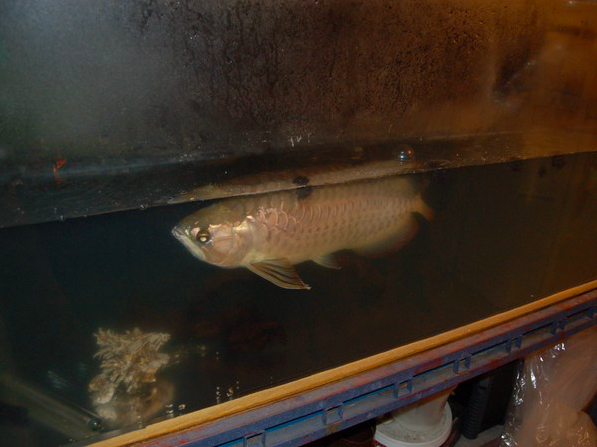
Shipping a large fish like an adult Asian arowana would be a daunting proposition for many aquarists; will such a large fish die from lack of oxygen while in transit? Will it get severely injured from thrashing about? How do you catch such a large fish in the first place? How expensive is it to ship a large fish by air?
The following article will explain in step-by-step fashion how a nine year old Red Tail Gold Asian arowana (Scleropages formosus) was shipped by air from Vancouver to Winnipeg, Canada on August 13, 2008. The fish measured two feet in length and came from SABF (Singapore Arowana Breeder Farm). It has had several owners. Recently the Vancouver based owner decided to sell the fish to a serious aro keeper who has large tanks and wants to try breeding the fish. The only problem is that the fellow lives in Winnipeg, Manitoba! I was asked to help out with the shipping and I agreed.
Part One – Choosing your shipper
If you want to ship a large fish across Canada these days you have two main carrier choices: Air Canada or West Jet. Air Canada has better schedules and more flights, but unheated cargo bays. Westjet has some indirect flights and is known to occasionally misdirect cargo – but it has heated cargo bays. Both airlines require shippers to have an account with them. This bears emphasis, as it takes about a week to obtain such an account and there is some paperwork involved. The requirement of having an account for shipping only started in early 2008 and probably has to do with security concerns related to the shipping of unaccompanied cargo. If you plan to ship a large fish, you must either go through the trouble to get your own shipping account or else find someone to help you who already has an account. The cargo booking needs to be made at least 24 hours in advance of departure and paid for by VISA or Mastercard over the phone. You must bring your fish to the cargo drop off location at least 2 hours before plane departure.
In my case, I opted to ship with Westjet as I have an account with them and have used them many times over the past few years to ship smaller Asian arowana across Canada. I also have access to pure bottled oxygen and thus am not overly concerned about Westjet misdirecting any given shipment – provided it is not winter!
Part Two – Preparations
Once you have booked your flight, you will need to prepare to catch and transport the fish. You will need a large styrofoam fish shipping box. These come in two standard sizes, the larger measuring 24″X18″X12. It is VERY IMPORTANT that your box be completely surrounded with cardboard or else the airline will refuse to take it. You might be able to source a styrofoam box inside a cardboard box at your local fish store; if you only have the styrofoam box, you can always make your own cardboard box by cutting and taping one to size.
You will also need to have a VERY LARGE transparent fish bag to catch the fish inside the aquarium. This technique is much better than using a net; it causes the fish less stress and makes much less mess. The trick is to fill the bag with water inside the aquarium and to then “steer” the fish into swimming inside it. This is a fairly easy technique to do with Asian arowana, but could prove much harder with other fish.
Your choice of shipping bag may or may not be the bag you use when catching the fish. I would recommend at least triple bagging a heavy duty 3 mm garbage bag. Asian arowana have very sharp pectoral fins as well as bony tongues; these can easily lead to a punctured bag. The absolute best bag to use is one available from seafood distributors for transporting shrimp and live fish. It is a heavy vinyl, transparent at top and opaque at the bottom.
I highly recommend adding pure oxygen to your fish bag as well. In my case I had access to pure bottled oxygen due to a family member requiring it.
A Case Study – What Can Go Wrong, Will Go Wrong!
I set my alarm clock for 4:30 am to get up and drive to the owner’s place. I had promised to take care of all aspects of shipping the fish provided the owner took care of providing a bag for shipping. Thus, I showed up all groggy at just past 5:00 am with my cardboard-covered styrofoam box and bottle of Bag Buddies. It didn’t take long to catch the fish using a large plastic bag. Then, the fish was transported to a large 3 mm heavy duty garbage bag. In the process of moving the fish, it thrashed around a lot, leading to some water spilling inside the styrofoam box. I neglected to pour this water out…This was mistake number one!
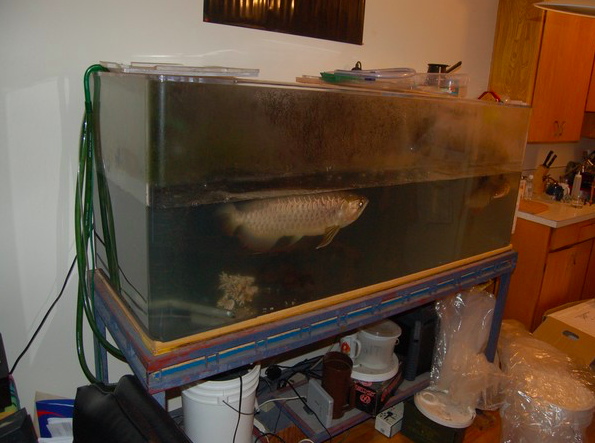


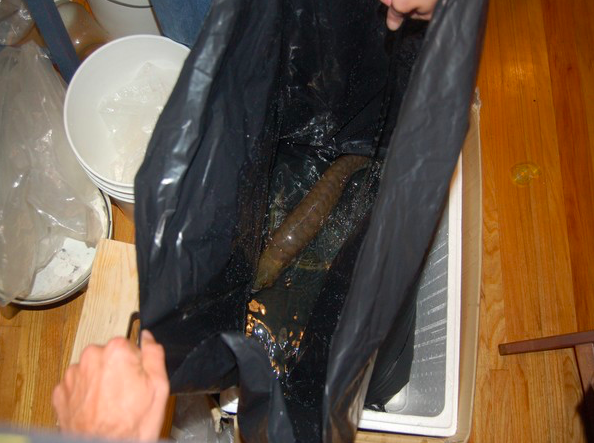
With the fish finally inside the garbage bag in the box, I hurriedly tied the bag shut with a heavy duty elastic band. Then, with both of us being tired and under stress, we collectively made mistake number two – we forgot to double or triple bag the fish! Instead, we bade a hasty farewell to one another; I left in a hurry with the fish, and headed off to another location to spike the fish’ bag with pure oxygen.


The oxygen added, I then drove to the airport to ship the fish. Unfortunately for me, the nicely packaged fish began to leak water when put on a dolly to move it to a scale. This led the Westjet lady on duty to tell me that “We WILL NOT take that fish on board the plane! The box is leaking! Take it away!” Luckily, I knew the manager on duty at the Westjet cargo terminal (he used to work for a big box fish store), and I convinced him that it was only extra water inside the styrofoam box that was displaced and leaking. Together we cut open the box, removed the bag, emptied the box of residual water, and repacked the fish. As the lid was closing for the final time on the fish, I thought to myself “Oh no. Single bagged fish!” As the fish was wheeled away it began thrashing like mad inside the box. Everyone laughed. I felt a little queezy inside…
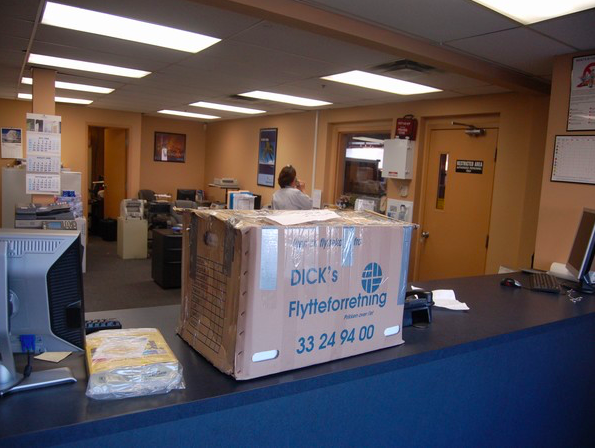
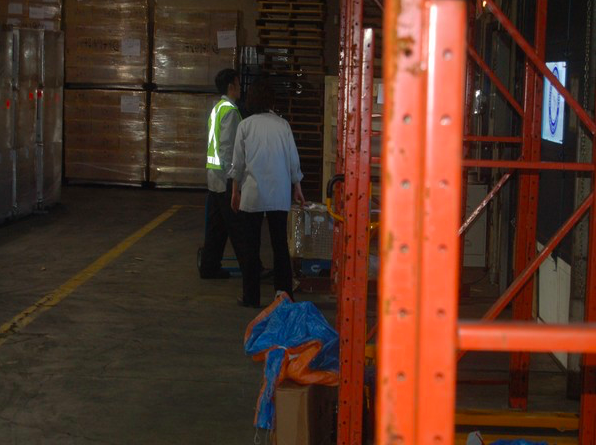
My job over, I went home and emailed the purchaser in Winnipeg that the fish was on its way.
The next 8 hours kind of crawled by. I couldn’t decide if the fish would make it or not, but was hopeful.
The fish arrived in Winnipeg at 1:35 pm and was released for pick-up about an hour later. Below are the four emails I received from the purchaser over the next few hours:
Email 1 : “Just picked up the arowana now. Will open at home”
Email 2: “I opened the box because I think someone opened it to check.. Half the water was out of the bag…but he is still alive. Rushing home now…”
Email 3: “Got the arowana home. Bag in tank with water dripping in and air bubble. Looking better….not up side down anymore.”
Email 4: “The arowana is doing good. He is swimming around his tank. Thanks for doing this.
As you can see from the attached photos, the arowana is adjusting nicely. When I picked it up from the airport, the box was open. I opened the box and discovered half the water was in the styrofoam container. The bag was wrapped around the arowana. It didn’t move for a while. I untangled the arowana from the bag and rushed home.
I decided to put the bag in the tank right away. I added an airstone and rigged up a pump to get water into the bag. I normally have the fish on the floor and drip water into the bag. I was afraid that there was a hole in the bag. He/she is now swimming around and looks good so far. I think the box was opened for inspection and they didn’t tie the bag that well. A clear shipping bag is good so they don’t have to open the bag (for next time).
I am happy and relieved. It is a nice looking fish. I will hopefully get it to spawn. I saw a 15 foot by 4 foot above ground pool at Zellers on sale for $200. I might pick it up for next summer breeding effort. Maybe I will set it up in my basement! 🙂
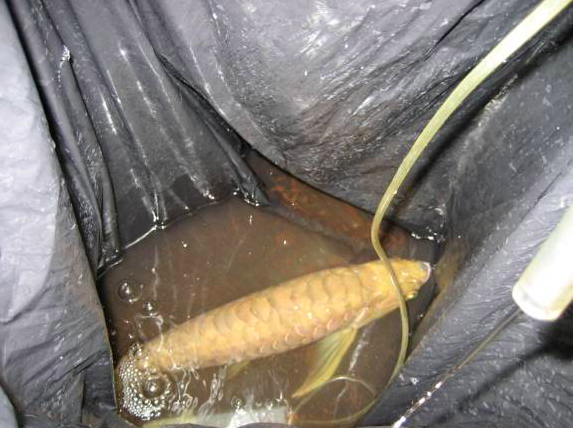
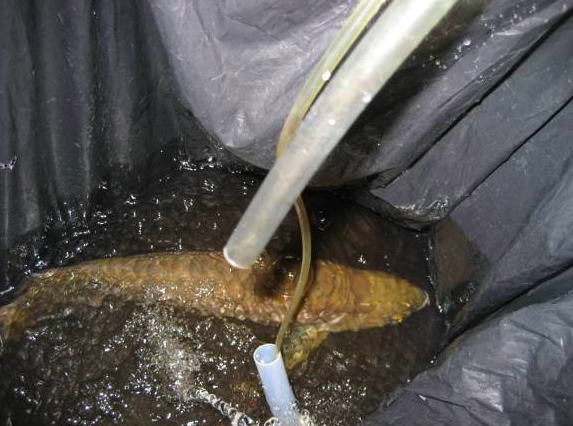
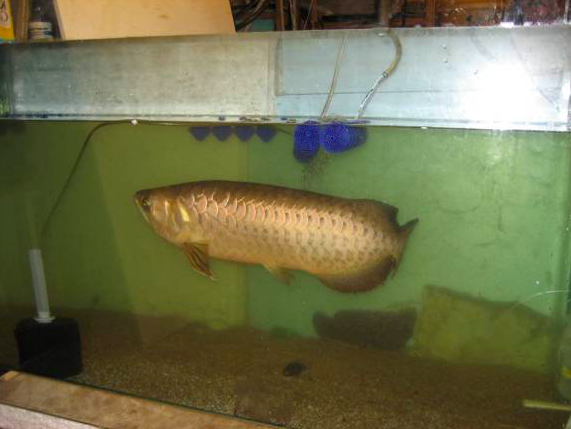
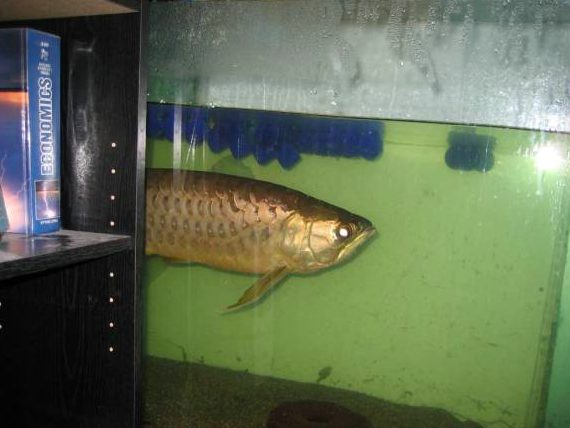
Conclusion
* Make sure you have an account with either Westjet or AirCanada or can find someone else who does
* Use a large, clear transparent bag for catching the fish and for transporting it; ideally double or triple bag the fish or use a specialized “sea food” bag
* Make sure there is no spilled water outside the bag in the styrofoam container
* Make sure your styrofoam container is inside a cardboard box for shipping purposes
* In winter, make sure you use disposable chemical warmers, available from most sport supply stores (they are used as foot or hand warmers by outdoorsmen in winter).
Arowana – True Fossil Fish
by Admin
Original article and photographs, 2008;
based on a translation of a museum display at Fur Island Museum, Denmark
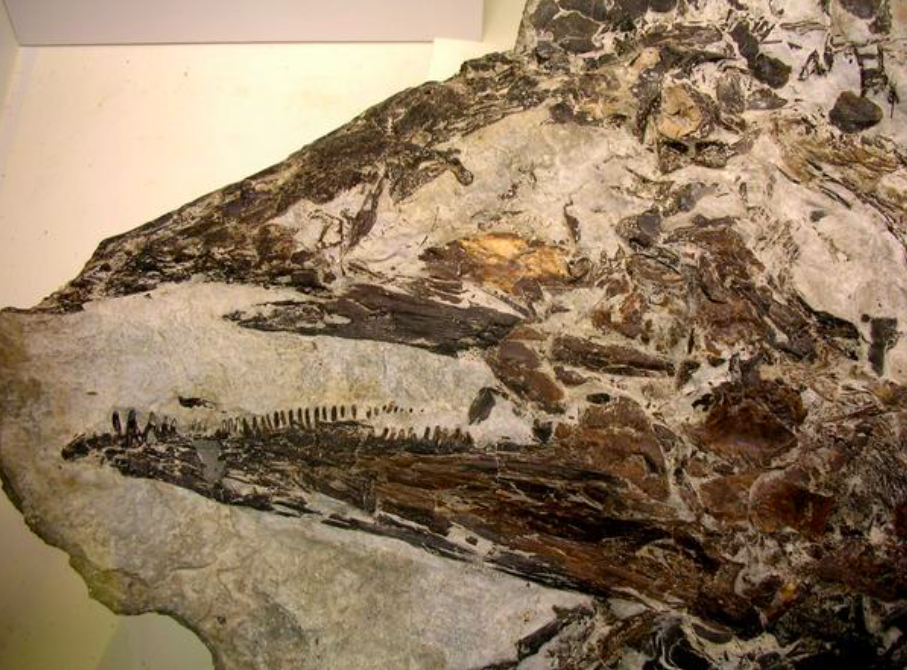
Being the Asian arowana-nut that I am (it is a big part of my aquarium hobby), I am always on the look-out for new information about them. It is not often in Denmark that new information comes my way. During a weekend get away a few weeks ago I decided to visit a local museum that is known to have a nice collection of fossilized fish. My kids bounded inside the building ahead of me while my wife and I stopped to pay our admission. Suddenly there was a huge commotion – my kids began shouting “Arowana! Arowana! Go show Daddy!”. My wife and I looked at each other, just a bit puzzled. Being dragged into the next room by my youngest, sure enough, there is a stuffed Asian arowana displayed on the wall. Accompanying it was a display of a major fossil find in the local area some years back that focussed on – you guessed it – the ancestor of the Asian arowana. Well, my wife may have rolled her eyes a little, but suddenly I was pretty interested in what this museum had to offer.
With my wife’s help I have been able to translate the Danish captions that accompany most of the items in the display.
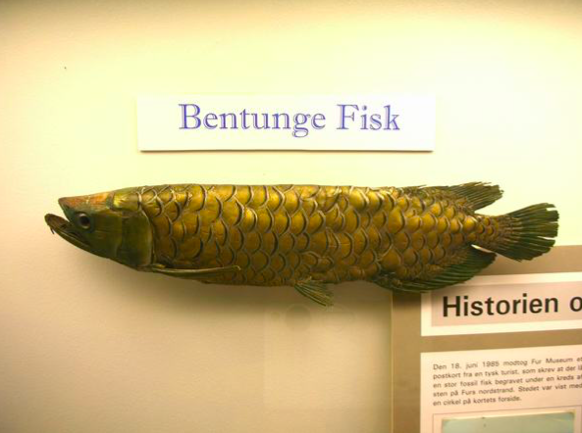
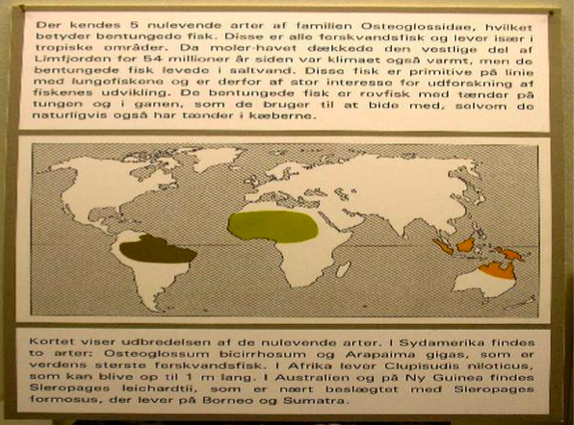
Contemporary Arowana Range (Translation of above map)
There are five types of fish in the family Osteoglossidae which exist today. The name Osteoglossidae means bone heavy fish. These are all freshwater fish and mainly live in tropical waters. When the Moler Ocean covered the western part of the Limfjorden, Denmark 54 million years ago, the climate was warm. At that time, the “bone heavy fish” lived in salt water. These fish today are as primitive as lung fish and are therefore of great interest to evolutionary biologists. The bone heavy fish are predators and have teeth on their tongue and on the roof of their mouth which they use to bite with. They also have teeth in their jaw.
The map diagram above shows their current distribution in the world today. In South America there are two species: Osteoglossum bicirrhosum (South American arowana) and Arapaima gigas, which are the world’s biggest freshwater fish. In Africa lives Clupisudis niloticus (African arowana), which can be up to one meter long. In Australia and New Guinea, there are Steropages leichardtii (Australian arowana), which are really closely related to Scleropages formosus (Asian arowana) which live in Borneo, Sumatra, and Peninsular Malaya.
Some interesting notes about the Arapaima gigas are that it has a swimming bladder that is adjusted to atmostpheric oxygen. Grown fish surface to breathe about 5 times an hours. Strangely enough, the best bait to catch the Arapaima gigas is the south American arowana!
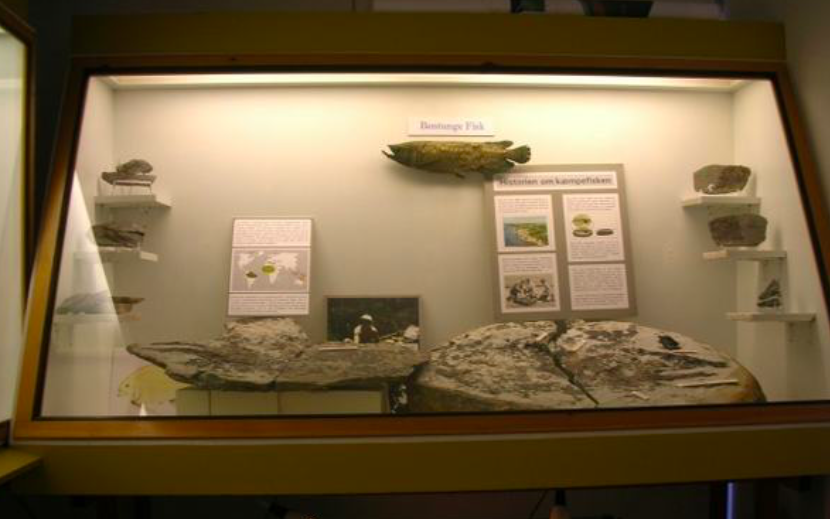
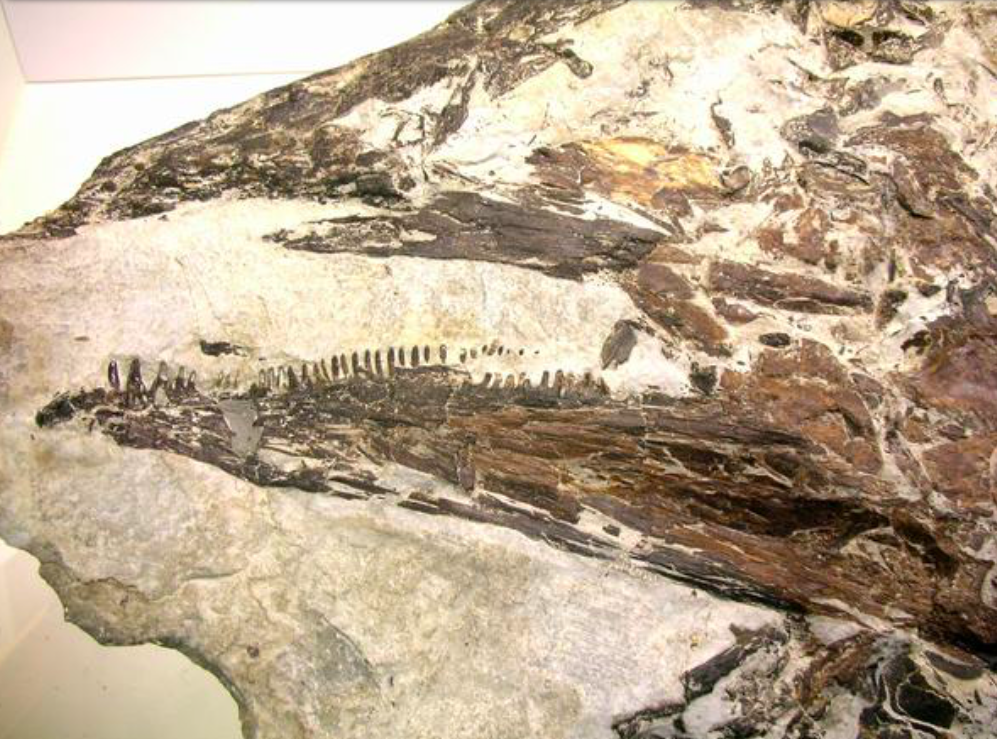
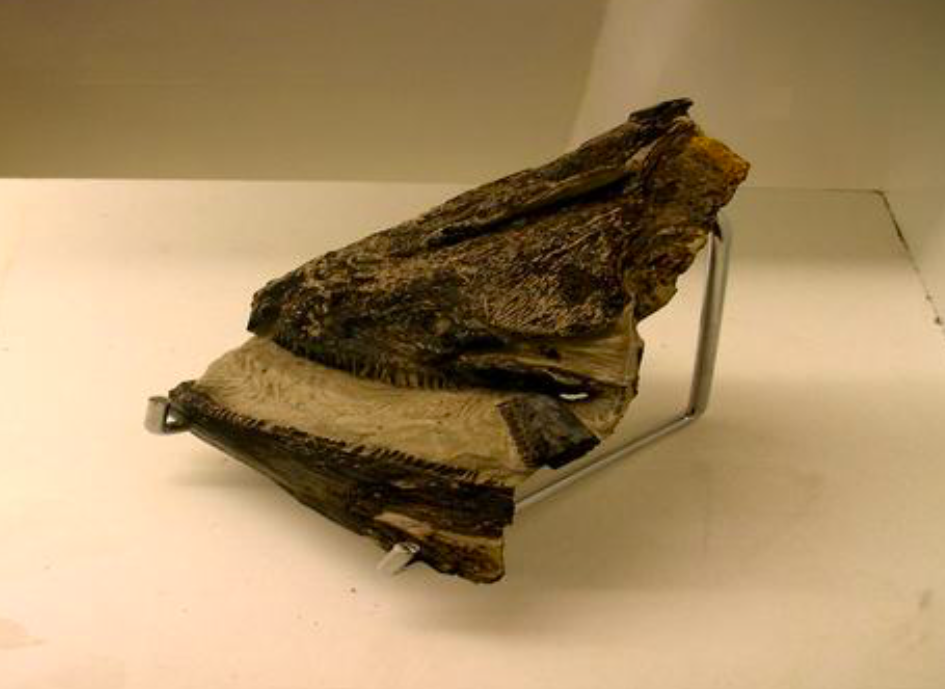
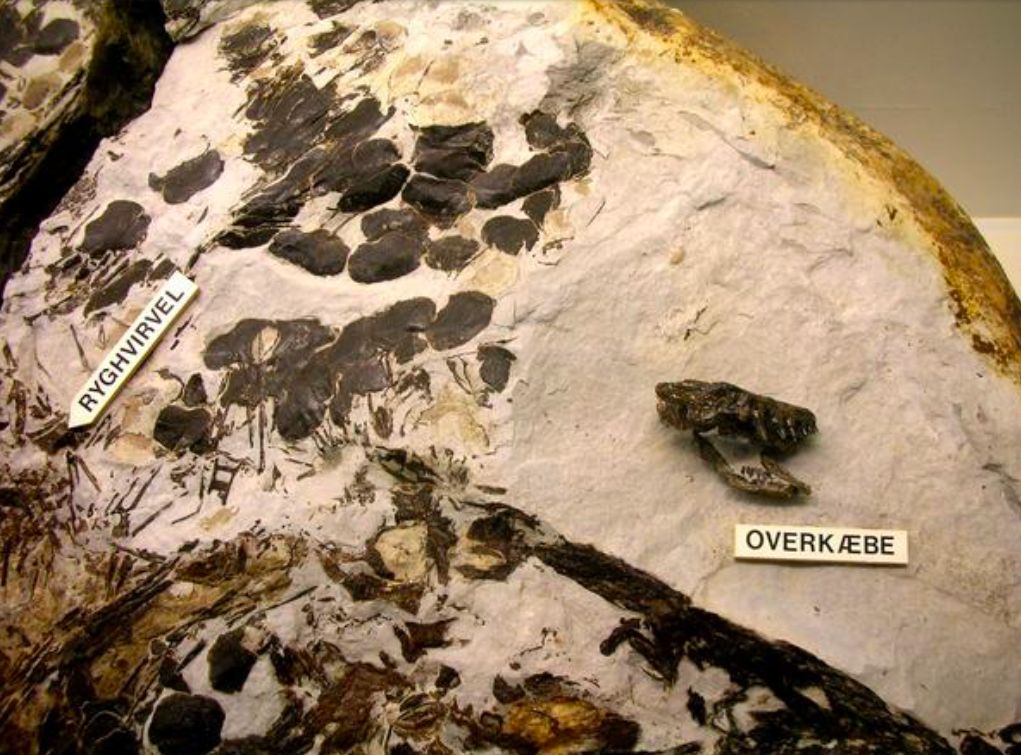
find in the surrounding area and so I spent a few hours looking…alas with no luck.
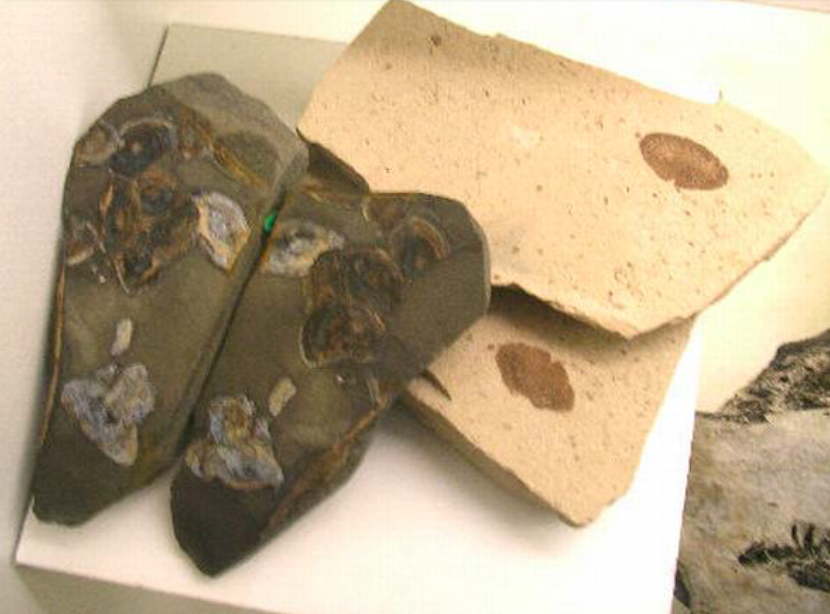
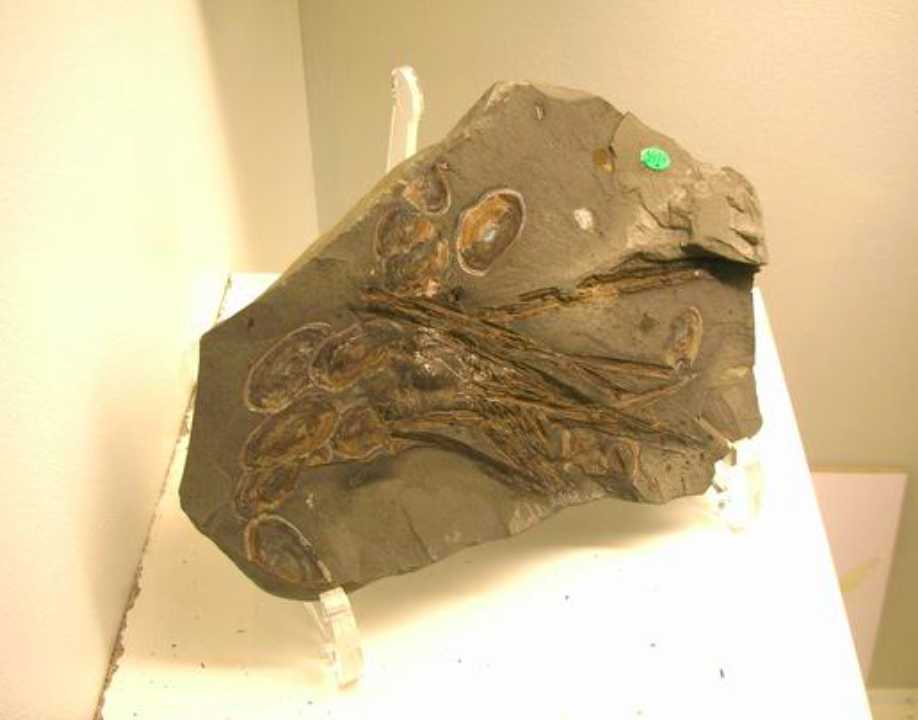
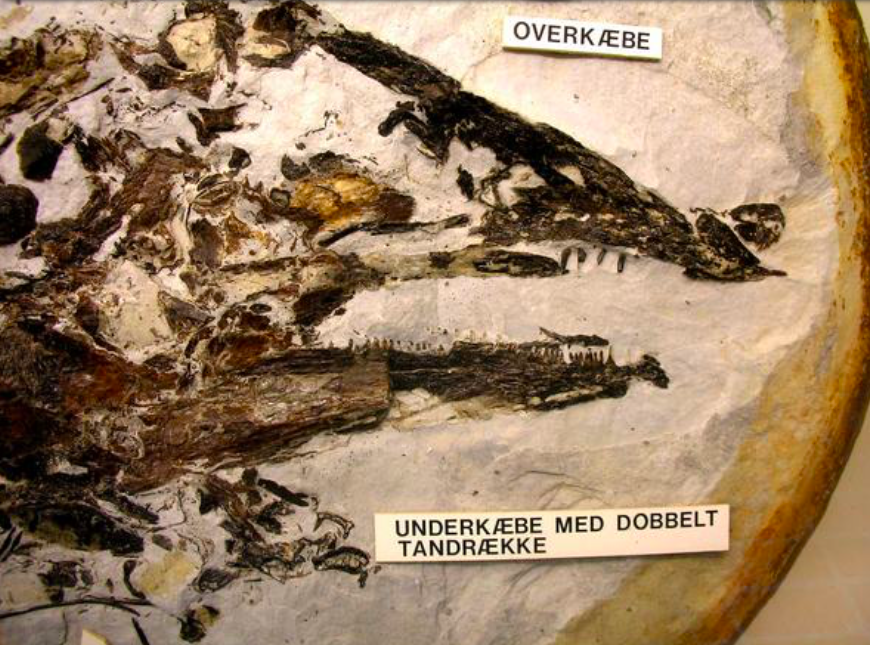
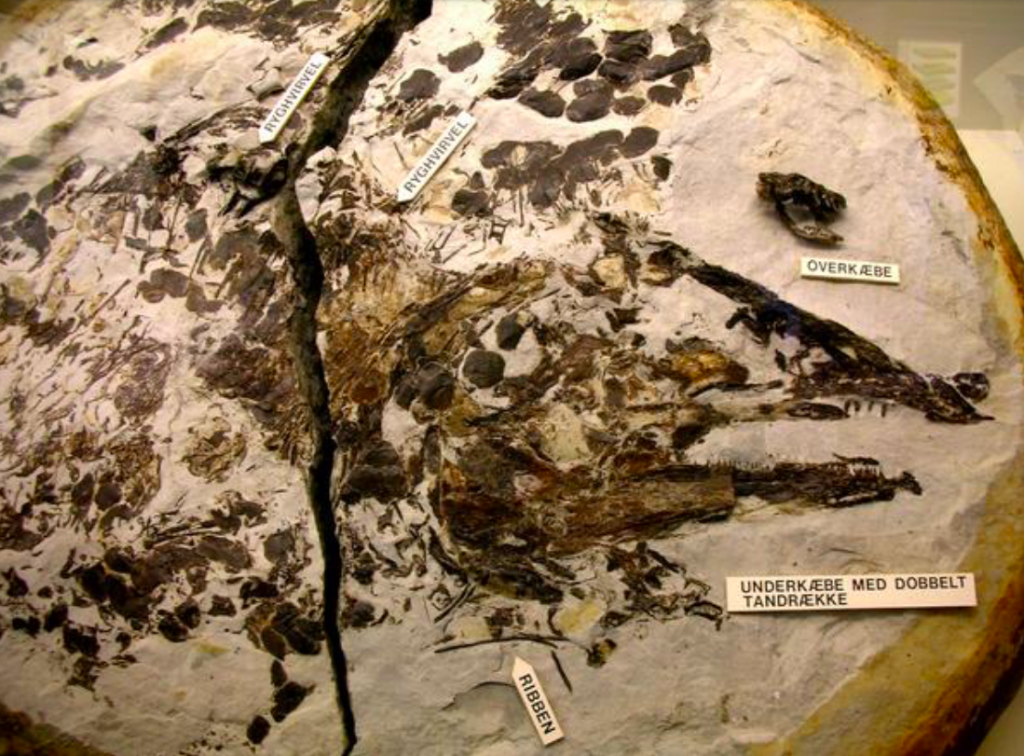
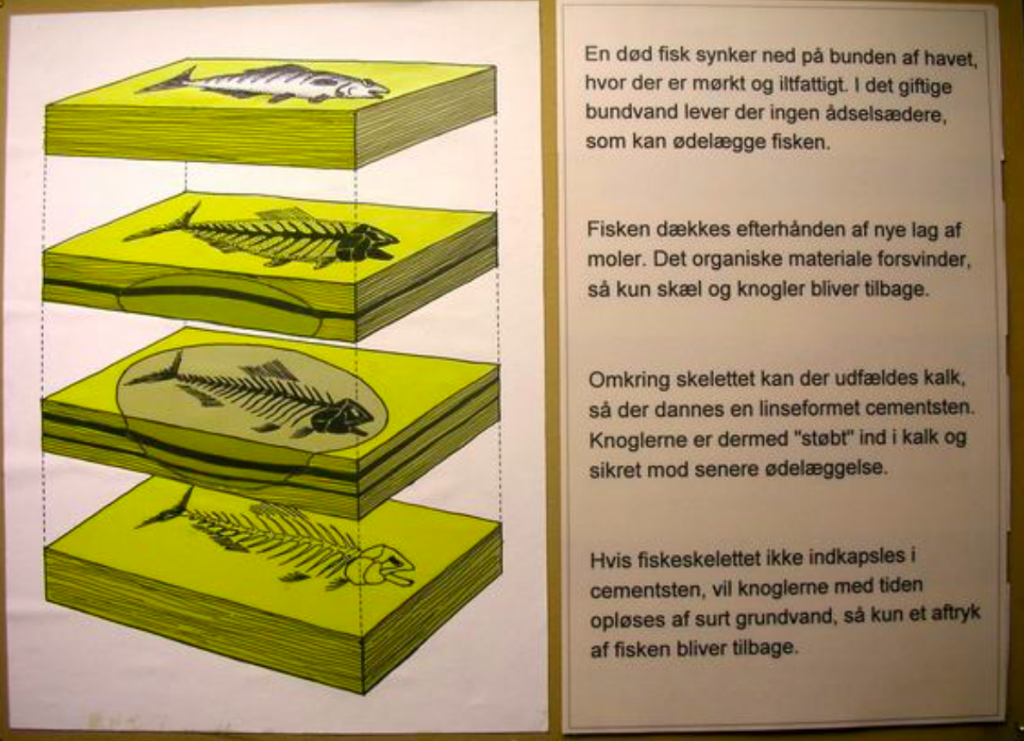
Fossil Formation (translation of text accompanying above diagram)
A dead fish sinks to the bottom of the ocean where it is dark and has little oxygen. In the poisonous aerobic bottom water, there are no scavengers, which would destroy the fish body.
Over time, the fish is covered by new layers of sediment, (Mole-clay). The organic material of the fish disappears and only scales and bones are left.
Around the skeleton, calcium can leach out, settle around the bones, and form a kind of calcium-stone cast. Because of this, the bones are now safe from later destruction.
If the fish skeleton is not safely encased in a calcium-stone cast, the bones will over time be dissolved by the acidic water and only an imprint of the fish will survive.
History of the Giant Fossil Fish
On June 18, 1985, Fur Museum got a post card from a German tourist. He wrote that a huge fossil fish lay under a circle of stone on Fur’s north beach. He had circled the area on a map on the postcard.
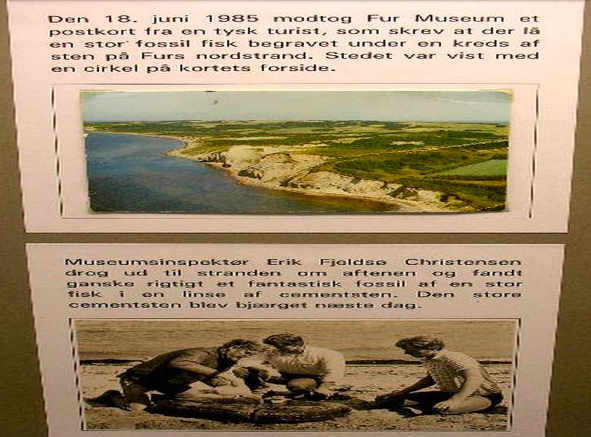
Photo of fossil recovery (bottom)
The museum director Erik Christiansen went out to the beach that night and he did find a fantastic fossil of a big fish in a lens of calcium-stone. The big calcium-stone was hauled out the next day.
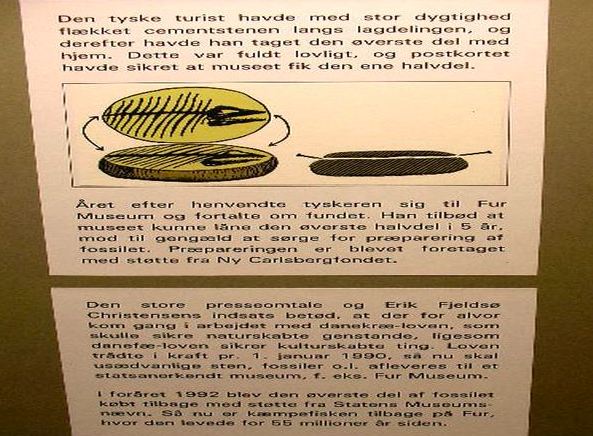
The German tourist had already skilfully split the rock along its horizontal layers. And then he had taken the top part home- which was legal! – and the post card ensured that the museum got the other half.
Next year the German tourist contacted the Fur museum to talk about the fossil find. He offered to lend the museum his top part of the fossil for five years if they fixed it up. The museum agreed, and the New Carlsburg Foundation paid for the restoration.
The enormous press coverage of the find and story, along with the efforts of the museum director Erik Christensen led to changes in the Danish laws governing ownership of artifacts of national historical value to Denmark. The new law was to secure new artifacts found for Denmark. The law came into effect in January 1990. So now, unusual rocks, fossils, etc., have to be delivered to national museums in Denmark (for example Fur Museum).
In the spring of 1992 the top part of the fossil was bought by a consortium of Danish museums “Statens Museums-nævn”. Now the entire giant fish is back in Fur where it had lain for the last 55 million years.
Conclusion
For evolutionary biologists, the ancient fossils of Osteoglossidae found around the world are evidence that all of the world’s continents were once joined together in one super-continent (Gondwanaland). Fossilised Osteoglossidae have been found in Europe, North America, Asia, India, Africa, and South America. The fact that the descendants of these truly ancient fish continue to inhabit many of these regions adds to their mistique. When it comes to the Asian arowana, it truly lays claim to being a living fossil fish.
Note: For further reading on the subject of the arowana ancestors, I recommend you look at the following links:
Article on fossilized Osteoglossidae skull found in India
PDF article on Fossilized Scleropages remains found in Belgium
